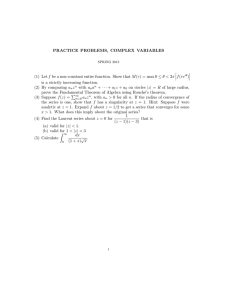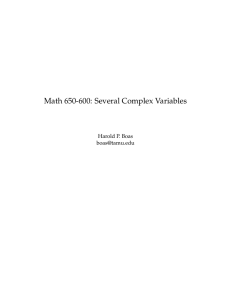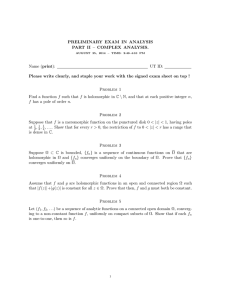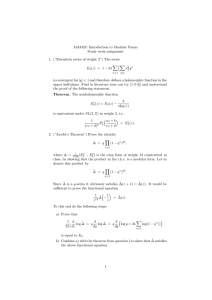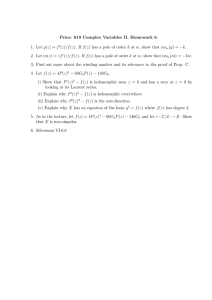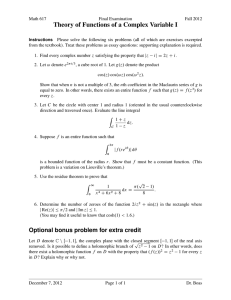Taylor and Laurent Series
advertisement
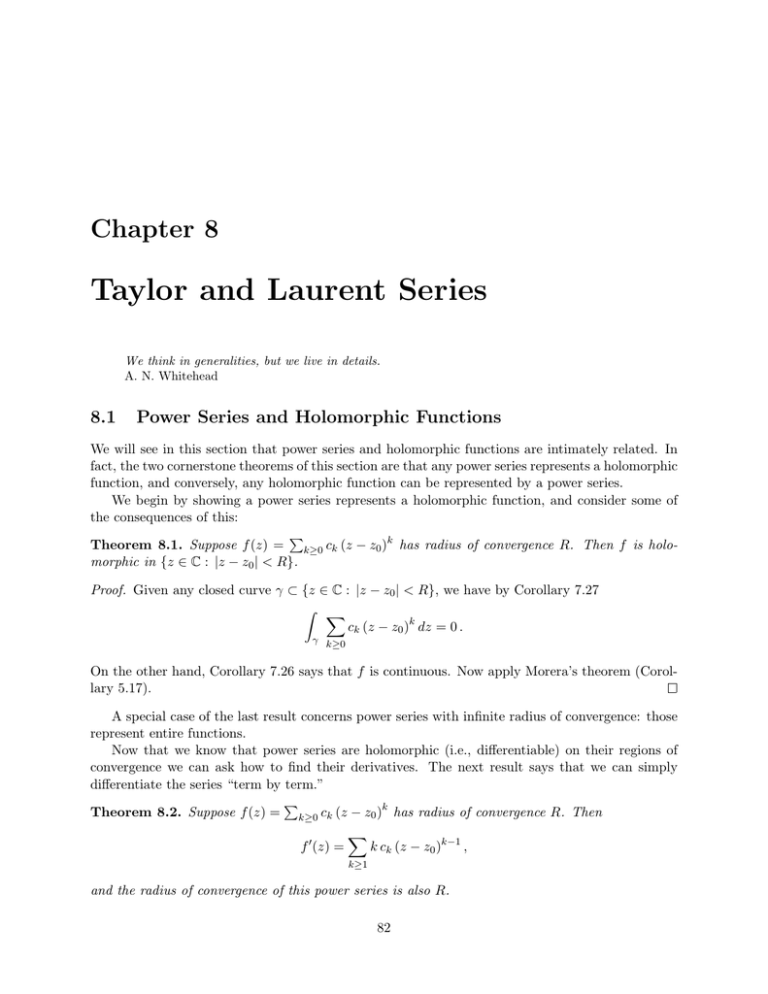
Chapter 8
Taylor and Laurent Series
We think in generalities, but we live in details.
A. N. Whitehead
8.1
Power Series and Holomorphic Functions
We will see in this section that power series and holomorphic functions are intimately related. In
fact, the two cornerstone theorems of this section are that any power series represents a holomorphic
function, and conversely, any holomorphic function can be represented by a power series.
We begin by showing a power series represents a holomorphic function, and consider some of
the consequences of this:
P
Theorem 8.1. Suppose f (z) = k≥0 ck (z − z0 )k has radius of convergence R. Then f is holomorphic in {z ∈ C : |z − z0 | < R}.
Proof. Given any closed curve γ ⊂ {z ∈ C : |z − z0 | < R}, we have by Corollary 7.27
Z X
ck (z − z0 )k dz = 0 .
γ k≥0
On the other hand, Corollary 7.26 says that f is continuous. Now apply Morera’s theorem (Corollary 5.17).
A special case of the last result concerns power series with infinite radius of convergence: those
represent entire functions.
Now that we know that power series are holomorphic (i.e., differentiable) on their regions of
convergence we can ask how to find their derivatives. The next result says that we can simply
differentiate the series “term by term.”
P
Theorem 8.2. Suppose f (z) = k≥0 ck (z − z0 )k has radius of convergence R. Then
f 0 (z) =
X
k ck (z − z0 )k−1 ,
k≥1
and the radius of convergence of this power series is also R.
82
CHAPTER 8. TAYLOR AND LAURENT SERIES
83
P
Proof. Let f (z) = k≥0 ck (z − z0 )k . Since we know that f is holomorphic in its region of convergence we can use Theorem 5.1. Let γ be any simple closed curve in {z ∈ C : |z − z0 | < R}. Note
that the power series of f converges uniformly on γ, so that we are free to interchange integral and
infinite sum. And then we use Theorem 5.1 again, but applied to the function (z − z0 )k . Here are
the details:
Z
f (w)
1
0
dw
f (z) =
2πi γ (w − z)2
Z P
k
1
k≥0 ck (w − z0 )
=
dw
2πi γ
(w − z)2
Z
X
(w − z0 )k
1
dw
=
ck ·
2πi γ (w − z)2
k≥0
X
d
=
ck ·
(w − z0 )k dw
w=z
k≥0
X
=
k ck (z − z0 )k−1 .
k≥0
The last statement of the theorem is easy to show: the radius of convergence R of f 0 (z) is at least
R (since we have shown that the series converges whenever |z − z0 | < R), and it cannot be larger
than R by comparison to the series for f (z), since the coefficients for (z − z0 )f 0 (z) are bigger than
the corresponding ones for f (z).
Naturally, the last theorem can be repeatedly applied to f 0 , then to f 00 , and so on. The various
derivatives of a power series can also be seen as ingredients of the series itself. This is the statement
of the following Taylor1 series expansion.
P
Corollary 8.3. Suppose f (z) = k≥0 ck (z − z0 )k has a positive radius of convergence. Then
ck =
f (k) (z0 )
.
k!
Proof. For starters, f (z0 ) = c0 . Theorem 8.2 gives f 0 (z0 ) = c1 . Applying the same theorem to f 0
gives
X
f 00 (z) =
k(k − 1)ck (z − z0 )k−2
k≥2
and
f 00 (z
0)
= 2c2 . We can play the same game for f 000 (z0 ), f 0000 (z0 ), etc.
Taylor’s formulas show that the coefficients of any power series which converges to f on an
open disk D centered at z0 can be determined from the the function f restricted to D. It follows
immediately that the coefficients of a power series are unique:
P
P
Corollary 8.4 (Uniqueness of power series). If k≥0 ck (z − z0 )k and k≥0 c0k (z − z0 )k are two
power series which both converge to the same function f (z) on an open disk centered at a then
ck = c0k for all k.
1
For more information about Brook Taylor (1685–1731), see
http://www-groups.dcs.st-and.ac.uk/∼history/Biographies/Taylor.html.
CHAPTER 8. TAYLOR AND LAURENT SERIES
84
We now turn to the second cornerstone result, that a holomorphic function can be represented
by a power series, and its implications.
Theorem 8.5. Suppose f is a function which is holomorphic in D = {z ∈ C : |z − z0 | < R}. Then
f can be represented in D as a power series centered at z0 (with a radius of convergence at least
R):
Z
X
1
f (w)
k
f (z) =
ck (z − z0 )
with
ck =
dw .
2πi γ (w − z0 )k+1
k≥0
Here γ is any positively oriented, simple, closed, smooth curve in D for which z0 is inside γ.
Proof. Let g(z) = f (z + z0 ); so g is a function holomorphic in {z ∈ C : |z| < R}. Fix r < R, denote
the circle centered at the origin with radius r by γr , and suppose that |z| < r. Then by Cauchy’s
integral formula (Theorem 4.10),
Z
1
g(w)
g(z) =
dw .
2πi γr w − z
The factor
1/(w − z) in this integral can be extended into a geometric series (note that w ∈ γr and
z
so w < 1)
1
1
1
1 X z k
=
z =
w−z
w 1− w
w
w
k≥0
which converges uniformly in the variable w ∈ γr (by Lemma 7.24). Hence Proposition 7.19 applies:
Z
Z
X 1 Z g(w)
g(w)
1
1
1 X z k
g(z) =
dw =
g(w)
dw =
dw z k .
2πi γr w − z
2πi γr
w
w
2πi γr wk+1
k≥0
k≥0
Now, since f (z) = g(z − z0 ), we apply an easy change of variables to obtain
X 1 Z
f (w)
f (z) =
dw (z − z0 )k ,
2πi Γr (w − z0 )k+1
k≥0
where Γr is a circle centered at z0 with radius r. The only difference of this right-hand side to the
statement of the theorem are the curves we’re integrating over. However, Γr ∼G\{z0 } γ, and we can
apply Cauchy’s Theorem 4.6:
Z
Z
f (w)
f (w)
dw
=
dw .
k+1
k+1
Γr (w − z0 )
γ (w − z0 )
If we compare the coefficients of the power series obtained in Theorem 8.5 with those in Corollary 8.3, we arrive at the long-promised extension of Theorem 5.1 (which in itself extended Cauchy’s
integral formula, Theorem 4.10).
Corollary 8.6. Suppose f is holomorphic on the region G, w ∈ G, and γ is a positively oriented,
simple, closed, smooth, G-contractible curve such that w is inside γ. Then
Z
f (z)
k!
(k)
dz .
f (w) =
2πi γ (z − w)k+1
CHAPTER 8. TAYLOR AND LAURENT SERIES
85
Corollary 8.6 combined with our often-used Proposition 4.4(d) gives an inequality which is often
called Cauchy’s Estimate:
Corollary 8.7. Suppose f is holomorphic in {z ∈ C : |z − w| < R} and |f | ≤ M . Then
k!M
(k)
f (w) ≤ k .
R
Proof. Let γ be a circle centered at w with radius r < R. Then Corollary 8.6 applies, and we can
estimate using Proposition 4.4(d):
k! Z
f (z)
k!
f (z)
(k)
length(γ) ≤ k! M 2πr = k!M .
dz ≤
max f (w) = k+1
k+1
2πi γ (z − w)
2π z∈γ (z − w)
2π rk+1
rk
The statement now follows since r can be chosen arbitrarily close to R.
8.2
Classification of Zeros and the Identity Principle
Basic algebra shows that if a polynomial p(z) of positive degree d has a a zero at a (in other words,
if p(a) = 0) then p(z) has z − a as a factor. That is, p(z) = (z − a)q(z) where q(z) is a polynomial
of degree d − 1. We can then ask whether q(z) itself has a zero at a and, if so, we can factor out
another factor of z − a. continuing in this way we see that we can factor p(z) as p(z) = (z − a)m g(z)
where m is a positive integer, not bigger than d, and g(z) is a polynomial which does not have a
zero at a. The integer m is called the multiplicity of the zero a of p(z).
Almost exactly the same thing happens for holomorphic functions:
Theorem 8.8 (Classification of Zeros). Suppose f is an holomorphic function defined on an open
set G and suppose f has a zero at a point a in G. Then there are exactly two possibilities:
(a) Either: f is identically zero on some open disk D centered at a (that is, f (z) = 0 for all z in
D);
(b) or: there is a positive integer m and a holomorphic function g, defined on G, satisfying f (z) =
(z − a)m g(z) for all z in G, with g(a) 6= 0
The integer m in the second case is uniquely determined by f and a and is called the multiplicity
of the zero at a.
Proof. We
P have a power series expansion for f (z) in some disk Dr (a) of radius r around a, so
f (z) = k≥0 ck (z − a)k , and c0 = f (0) is zero since a is a zero of f . There are now exactly two
possibilities:
(a) Either ck = 0 for all k;
(b) or there is some positive integer m so that ck = 0 for all k < m but cm 6= 0.
The first case clearly gives us f (z) = 0 for all z in D = Dr (a). So now consider the second case.
Notice that
f (z) = cm (z − a)m + cm+1 (z − a)m+1 + · · · = (z − a)m (cm + cm+1 (z − a) + · · · )
X
= (z − a)m
ck+m (z − a)k .
k≥0
CHAPTER 8. TAYLOR AND LAURENT SERIES
Then we can define a function g on G by
P
k
k≥0 ck+m (z − a)
g(z) =
f (z)
(z − a)m
86
if |z − a| < r
if z ∈ G \ {a}
According to our calculations above, the two definitions give the same value when both are applicable. The function g is holomorphic at a by the first definition; and g is holomorphic at other
points of G by the second definition. Finally, g(a) = cm 6= 0.
Clearly m is unique, since it is defined in terms of the power series expansion of f at a, which
is unique.
To start using the intimate connection of holomorphic functions and power series, we apply
Theorem 8.8 to obtain the following result, which is sometimes also called the uniqueness theorem.
Theorem 8.9 (Identity Principle). Suppose f and g are holomorphic in the region G and f (zk ) =
g(zk ) at a sequence which converges to w ∈ G with zk 6= w for all k. Then f (z) = g(z) for all z in
G.
Proof. We start by defining h = f − g. Then h is holomorphic on G, h(zn ) = 0, and we will be
finished if we can deduce that h is identically zero on G. Now notice the following: If b is in G then
exactly one of the following occurs:
(a) Either there is an open disk D centered at b so that h(z) = 0 for all z in D;
(b) or there is an open disk D centered at b so that h(z) 6= 0 for all z in D \ {b}.
To see this, suppose that h(b) 6= 0. Then, by continuity, there is an open disk D centered at
b so that h(z) 6= 0 for all z ∈ D, so b satisfies the second condition. If h(b) = 0 then, by the
classification of zeros, either h(z) = 0 for all z in some open disk D centered at b, so b satisfies the
first condition; or h(z) = (z − b)m φ(z) for all z in G, where φ is holomorphic and φ(b) 6= 0. Then,
since φ is continuous, there is an open disk D centered at b so that φ(z) 6= 0 for all z in D. Then
h(z) = (z − b)m φ(z) 6= 0 for all z in D except z = b, so b satisfies the second condition.
Now define two sets X, Y ⊆ G, so that b ∈ X if b satisfies the first condition above, and b ∈ Y
if b satisfies the second condition. If b ∈ X and D is an open disk centered at b as in the first
condition then it is clear that D ⊆ X. If b ∈ Y and D is an open disk centered at b as in the second
condition then D ⊆ Y , since if z ∈ D \ {b} then h(z) 6= 0, and we saw that this means z satisfies
the second condition.
Finally, we check that our original point w lies in X. To see this, suppose w ∈ Y , and let
D be an open disk centered at w so that h(z) 6= 0 for all z in D except z = b. But, since the
sequence zk converges to w, there is some k so that zk is in D, so h(zk ) = 0. Since zk 6= w, this is
a contradiction.
Now we finish the proof using the definition of connectedness. X and Y are disjoint open sets
whose union is G, so one of them must be empty. Since a is in X, we must have Y = ∅ and X = G.
But X = G implies that every z in G satisfies the first condition above, so h(z) = 0.
Using the identity principle, we can prove yet another important property of holomorphic
functions.
CHAPTER 8. TAYLOR AND LAURENT SERIES
87
Theorem 8.10 (Maximum-Modulus Theorem). Suppose f is holomorphic and not constant in the
region G. Then |f | does not attain a weak relative maximum in G.
There are many reformulations of this theorem, such as: If G is a bounded region and f is
holomorphic in the closure of G, then the maximum of |f | is attained on the boundary of G.
Proof. Suppose there is a point a in G and an open disk D0 centered at a so that |f (a)| ≥ |f (z)|
for all z in D0 . If f (a) = 0 then f (z) = 0 for all z in D0 , so f is identically zero, by the
identity principle. So we assume f (a) 6= 0. In this case we can define an holomorphic function
g(z) = f (z)/f (a), and we have the condition |g(z)| ≤ |g(a)| = 1 for all z in D0 . Since g(a) = 1
we can find, using continuity, a smaller open disk D centered at a so that g(z) has positive real
part for all z in D. Thus the function h = Log ◦g is defined and holomorphic on D, and we have
h(a) = Log(g(a)) = Log(1) = 0 and Re h(z) = Re Log(g(z)) = ln(|g(z)|) ≤ ln(1) = 0.
We now refer to Exercise 27, which shows that h must be identically zero in D. Hence g(z) =
eh(z) must be equal to e0 = 1 for all z in D, and so f (z) = f (a)g(z) must have the constant value
f (a) for all z in D. Hence, by the identity principle, f (z) has the constant value f (a) for all z
in G.
Theorem 8.10 can be used to give a proof of the analogous theorem for harmonic functions,
Theorem 6.6, in the process strengthening that theorem to cover weak maxima and weak minima.
Corollary 8.11. If u is harmonic in the region G, then it does not have a weak relative maximum
or minimum in G.
Since the last corollary also covers minima of harmonic functions, we should not be too surprised
to find the following result whose proof we leave for the exercises.
Corollary 8.12 (Minimum-Modulus Theorem). Suppose f is holomorphic and not constant in the
region G. Then |f | does not attain a weak relative minimum at a in G unless f (a) = 0.
8.3
Laurent Series
Theorem 8.5 gives a powerful way of describing holomorphic functions. It is, however,
not as general
as it could be. It is natural, for example, to think about representing exp z1 as
X k X
1 −k
1
1 1
exp
=
=
z ,
z
k! z
k!
k≥0
k≥0
a “power series” with negative exponents. To make sense of expressions like the above, we introduce
the concept of a double series
X
X
X
ak =
ak +
a−k .
k∈Z
k≥0
k≥1
Here ak ∈ C are terms indexed by the integers. A double series converges if both its defining series
do. Absolute and uniform convergence are defined analogously. Equipped with this, we can now
state the following central definition.
CHAPTER 8. TAYLOR AND LAURENT SERIES
88
Definition 8.13. A Laurent2 series centered at z0 is a double series of the form
P
Example 8.14. The series which started this section is the Laurent series of exp
0.
k∈Z ck
1
z
(z − z0 )k .
centered at
Example 8.15. Any power series is a Laurent series (with ck = 0 for k < 0).
We should pause for a minute and ask for which z such a Laurent series can possibly converge.
By definition
X
X
X
ck (z − z0 )k =
ck (z − z0 )k +
c−k (z − z0 )−k .
k∈Z
k≥0
k≥1
The first of the series on the right-hand side is a power series with some radius of convergence
R2 , that is, it converges in {z ∈ C : |z − z0 | < R2 }. The second we can view as a “power series in
1
1
1
z−z0 ,” it will converge for |z−z0 | < |R1 | for some R1 , that is, in {z ∈ C : |z − z0 | > R1 }. For the
convergence of our Laurent series, we need to combine those two notions, whence the Laurent series
converges on the annulus {z ∈ C : R1 < |z − z0 | < R2 } (if R1 < R2 ). Even better, Theorem 7.25
implies that the convergence is uniform on a set of the form {z ∈ C : r1 ≤ |z − z0 | ≤ r2 } for any
R1 < r1 < r2 < R2 . Theorem 8.1 says that the Laurent series represents a function which
is holomorphic on {z ∈ C : R1 < |z − z0 | < R2 }. The fact that we can conversely represent any
function holomorphic in such an annulus by a Laurent series is the substance of the next theorem.
Theorem 8.16. Suppose f is a function which is holomorphic in A = {z ∈ C : R1 < |z − z0 | < R2 }.
Then f can be represented in A as a Laurent series centered at z0 :
Z
X
1
f (w)
k
f (z) =
ck (z − z0 )
with
ck =
dw .
2πi γ (w − z0 )k+1
k∈Z
Here γ is any circle in A centered at z0 .
Remark. Naturally, by Cauchy’s Theorem 4.6 we can replace the circle in the formula for the
Laurent series by any closed, smooth path that is A-homotopic to the circle.
Proof. Let g(z) = f (z + z0 ); so g is a function holomorphic in {z ∈ C : R1 < |z| < R2 }. Fix
R1 < r1 < |z| < r2 < R2 , and let γ1 and γ2 be positively oriented circles centered at 0 with radii
r1 and r2 , respectively. By introducing an “extra piece” (see Figure 8.1), we can apply Cauchy’s
integral formula (Theorem 4.10) to the path γ2 − γ1 :
Z
Z
Z
1
g(w)
1
g(w)
1
g(w)
g(z) =
dw =
dw −
dw .
(8.1)
2πi γ2 −γ1 w − z
2πi γ2 w − z
2πi γ1 w − z
For the integral over γ2 we play exactly the same game as in Theorem 8.5. The factor
1/(w − z) in
z
this integral can be expanded into a geometric series (note that w ∈ γ2 and so w < 1)
1
1
1
=
w−z
w 1−
z
w
=
1 X z k
,
w
w
k≥0
2
For more information about Pierre Alphonse Laurent (1813–1854), see
http://www-groups.dcs.st-and.ac.uk/∼history/Biographies/Laurent Pierre.html.
CHAPTER 8. TAYLOR AND LAURENT SERIES
89
Figure 8.1: Proof of Theorem 8.16.
which converges uniformly in the variable w ∈ γ2 (by Lemma 7.24). Hence Proposition 7.19 applies:
Z
Z
X Z g(w)
g(w)
1 X z k
dw =
dw =
g(w)
dw z k .
k+1
w
w
γ2 w − z
γ2 w
γ2
k≥0
k≥0
The integral over γ1 is computed in a similar fashion;
we expand the factor 1/(w − z) into the
now
following geometric series (note that w ∈ γ1 and so wz < 1)
1
1 X w k
1 1
=
−
=−
,
w−z
z 1 − wz
z
z
k≥0
which converges uniformly in the variable w ∈ γ1 (by Lemma 7.24). Again Proposition 7.19 applies:
Z
Z
XZ
X Z g(w)
1 X w k
g(w)
k
−k−1
dw = −
g(w)
dw = −
g(w)w dw z
=−
dw z k .
k+1
w
−
z
z
z
w
γ1
γ1
γ1
γ1
k≥0
k≥0
k≤−1
Putting everything back into (8.1) gives
Z
X Z g(w)
1 X
g(w)
k
g(z) =
dw z +
dw z k .
k+1
k+1
2πi
w
w
γ2
γ1
k≥0
k≤−1
We can now change both integration paths to a circle γ centered at 0 with a radius between R1
and R2 (by Cauchy’s Theorem 4.6), which finally gives
Z
1 X
g(w)
g(z) =
dw z k .
k+1
2πi
w
γ
k∈Z
The statement follows now with f (z) = g(z − z0 ) and an easy change of variables.
CHAPTER 8. TAYLOR AND LAURENT SERIES
90
We finish this chapter with a consequence of the above theorem: because the coefficients of a
Laurent series are given by integrals, we immediately obtain the following:
Corollary 8.17. The coefficients of a Laurent series are unique.
This result seems a bit artificial; what it says is simply the following: if we expand a function
(that is holomorphic in some annulus) into a Laurent series, there is only one possible outcome.
Exercises
1. For each of the following series, determine where the series converges absolutely/uniformly:
X
(a)
k(k − 1) z k−2 .
k≥2
1
z 2k+1 .
(2k + 1)!
k≥0
X 1 k
.
(c)
z−3
(b)
X
k≥0
2. What functions are represented by the series in the previous exercise?
3. Find the power series centered at 1 for exp z.
4. Prove Lemma 3.16 using the power series of exp z centered at 0.
5. By integrating a series for
radius of convergence?
1
1+z 2
term by term, find a power series for arctan(z). What is its
6. Find the terms through third order and the radius of convergence of the power series for each
following functions, centered at z0 . Do not find the general form for the coefficients.
(a) f (z) =
(b) f (z) =
(c) f (z) =
1
,
1+z 2
1
ez +1 ,
√
z0 = 1.
z0 = 0.
1 + z, z0 = 0 (use the principal branch).
2
(d) f (z) = ez , z0 = i.
7. Prove the following generalization of Theorem 8.1: Suppose fn are holomorphic on the region
G and converge uniformly to f on G. Then f is holomorphic in G. (This result is called the
Weierstraß convergence theorem.)
8. Use the previous exercise and Corollary 8.7 to prove the following: Suppose fn are holomorphic
on the region G and converge uniformly to f on G. Then for any k ∈ N, the k th derivatives
(k)
fn converge (pointwise) to f (k) .
9. Prove the minimum-modulus theorem (Corollary 8.12).
CHAPTER 8. TAYLOR AND LAURENT SERIES
91
10. Find the maximum and minimum of |f (z)| on the unit disc {z ∈ C : |z| ≤ 1}, where
f (z) = z 2 − 2.
11. Give another proof of the fundamental theorem of algebra (Theorem 5.7), using the minimum-modulus theorem (Corollary 8.12). (Hint: Use Lemma 5.6 to show that a polynomial
does not achieve its minimum modulus on a large circle; then use the minimum-modulus
theorem to deduce that the polynomial has a zero.)
12. Find a Laurent series for
converges.
1
(z−1)(z+1)
13. Find a Laurent series for
1
z(z−2)2
14. Find a Laurent series for
z−2
z+1
centered at z = 1 and specify the region in which it
centered at z = 2 and specify the region in which it converges.
centered at z = −1 and specify the region in which it converges.
15. Find the first five terms in the Laurent series for
1
sin z
centered at z = 0.
16. Find the first 4 non-zero terms in the power series expansion of tan z centered at the origin.
What is the radius of convergence?
17. (a) Find the power series representation for eaz centered at 0, where a is any constant.
(b) Show that ez cos(z) = 21 e(1+i)z + e(1−i)z .
(c) Find the power series expansion for ez cos(z) centered at 0.
P
1
18. Show that z−1
k≥0 (z−1)k for |z − 1| > 1.
z−2 =
19. Prove: If f is entire and Im(f ) is constant on the unit disc {z ∈ C : |z| ≤ 1} then f is
constant.
20. (a) Find the Laurent series for
cos z
z2
centered at z = 0.
(b) Prove that
f (z) =
cos z−1
z2
− 21
if z 6= 0,
if z = 0
is entire.
21. Find the Laurent series for sec z centered at the origin.
22. Suppose that f (z0 ) = 0 and f 0 (z0 ) 6= 0. Show that f has a zero of multiplicity 1 at z0 .
23. Find the multiplicities of the zeros:
(a) f (z) = ez − 1, z0 = 2kπi, where k is any integer.
(b) f (z) = sin(z) − tan(z), z0 = 0.
(c) f (z) = cos(z) − 1 + 12 sin2 (z), z0 = 0.
24. Find the zeros of the following, and determine their multiplicities:
(a) (1 + z 2 )4 .
CHAPTER 8. TAYLOR AND LAURENT SERIES
92
(b) sin2 z.
(c) 1 + ez .
(d) z 3 cos z.
1
25. Find the three Laurent series of f (z) = (1−z)(z+2)
, centered at 0, but which are defined on
the three domains |z| < 1, 1 < |z| < 2, and 2 < |z|, respectively. Hint: Use Theorem 8.16.
26. Suppose that f (z) has exactly one zero, at a, inside the circle γ, and that it has multiplicity 1.
R zf 0 (z)
1
Show that a = 2πi
γ f (z) dz.
27. Suppose f is holomorphic and not identically zero on an open disk D centered at a, and
suppose f (a) = 0. Follow the following outline to show that Re f (z) > 0 for some z in D.
(a) Why can you write f (z) = (z − a)m g(z) where m > 0, g is holomorphic, and g(a) 6= 0?
(b) Write g(a) in polar form as g(a) = c eiα and define G(z) = e−iα g(z). Why is Re G(a) > 0?
(c) Why is there a positive constant δ so that Re G(z) > 0 for all z in the open disk Dδ (a)?
(d) Write z = a + reiθ for 0 < r < δ. Show that f (z) = rm eimθ eiα G(z).
(e) Find a value of θ so that f (z) has positive real part.
P
28. Suppose |cn | ≥ 2n for all n. What can you say about the radius of convergence of k≥0 ck z k ?
P
29. Suppose the radius of convergence of k≥0 ck z k is R. What is the radius of convergence of
each of the following?
X
(a)
k 2 ck z k .
k≥0
(b)
X
(c)
X
(d)
X
(e)
X
ck z 2k .
k≥0
ck z k+5 .
k≥0
3k ck z k .
k≥0
k≥0
c2k z k .
